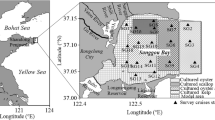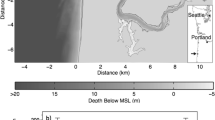Abstract
There is mounting speculation that overharvesting of oyster stocks (Crassostrea virginica) in Chesapeake Bay may be a factor contributing to the decline in water quality and shifts in the dominance of species inhabiting the estuary. The trophic consequences of increasing the oyster population may be addressed using a simple quasi-equilibrium, mass action model of the exchanges transpiring in the Chesapeake mesohaline ecosystem. According to output from the model, increasing oyster abundance would decrease phytoplankton productivity as well as stocks of pelagic microbes, ctenophores, medusae, and particulate organic carbon. Recently acquired field data on phytoplankton productivity, bacterioplankton, and labile organic carbon in the vicinity of rafted oyster aquaculture support model predictions. The model also indicates that more oysters should increase benthic primary production, fish stocks, and mesozooplankton densities. Hence, augmenting the oyster community by restoring beds or introducing raft culture represents a potentially significant adjunct to the goal of mitigating eutrophication through curtailment of nutrient inputs. *** DIRECT SUPPORT *** A01BY059 00005
Similar content being viewed by others
Literature Cited
Baird, D. and R. E. Ulanowicz. 1989. The seasonal dynamics of the Chesapeake Bay ecosystem. Ecological Monographs 59: 329–364.
Biggs, R. B. and B. A. Howell. 1984. The estuary as a sediment trap: Alternative approaches to estimating its filtering efficiency, p. 107–129. In V. S. Kennedy (ed.), The Estuary As a Filter. Academic Press, Orlando, Florida.
Diaz, R. J. and L. C. Schaffner. 1990. The functional role of estuarine benthos, p. 25–56. In M. Haire and E. C. Krone (eds.), Perspectives on the Chesapeake Bay 1990. Chesapeake Research Consortium, Gloucester Point, Virginia.
Gerritsen, J., A. Ranasinghe, and A. F. Holland. 1989. Comparison of three strategies to improve water quality in the Maryland portion of Chesapeake Bay. Report to the Maryland Department of Natural Resources, Annapolis, Maryland. Appendix C. 20 p.
Horton, T. 1984. Oysters’ brief “survival season” is focus of studies, p. 1C. Baltimore Sun August 5, 1984. Baltimore, Maryland.
Jonas, R. B. and J. H. Tuttle. 1990. Bacterioplankton and organic carbon dynamics in the lower mesohaline Chesapeake Bay. Applied Environmental Microbiology 56:747–757.
Jonas, R. B. and J. H. Tuttle. 1991. Improving Chesapeake Bay water quality: Influences of rafted oyster aquaculture on microbial processes and organic carbon. p. 323–329. In J. A. Mihursky and A. Chaney (eds.), New Perspectives on the Chesapeake Bay. Publication #137, Chesapeake Research Consortium, Solomons, Maryland.
Newell, R. I. E. 1988. Ecological changes in Chesapeake Bay: Are they the result of overharvesting the American oyster, Crassostrea virginica? p. 536–546. In M. P. Lynch and E. C. Krome (eds.), Understanding the Estuary: Advances in Chesapeake Bay Research, Chesapeake Research Consortium, Solomons, Maryland.
Power, M. E. 1990. Effects of fish in river food webs. Science 250:811–814.
Press, W. H., B. P. Flannery, S. A. Tukolsky, and W. T. Vetterling. 1986. Numerical Recipes: The Art of Scientific Computing. Cambridge University Press, New York. 818 p.
Szyrmer, J. and R. E. Ulanowicz. 1987. Total flows in ecosystems. Ecological Modelling 35:123–136.
Tuttle, J. H., R. B. Jonas, and T. C. Malone. 1987b. Origin, development and significance of Chesapeake Bay anoxia, p. 442–472. In S. K. Malumdar, L. W. Hall, Jr., and H. M. Austin (eds.), Contaminant Problems and Management of Living Chesapeake Bay Resources. Pennsylvania Academy of Sciences, Philadelphia.
Tuttle, J. H., T. Malone, R. Jonas, H. Ducklow, and D. Cargo. 1985. Nutrient-dissolved oxygen dynamics: Roles of phytoplankton and microheterotrophs under summer conditions. Report to United States Environmental Protection Agency. University of Maryland [UMCEES] CBL 85-39. Chesapeake Biological Laboratory, Solomons, Maryland. 121 p.
Tuttle, J. H., T. Malone, R. Jonas, H. Ducklow, and D. Cargo. 1987a. Nutrient-dissolved oxygen dynamics: Roles of phytoplankton and microheterotrophs under summer conditions, 1985. Report to United States Environmental Protection Agency. Annapolis, Maryland. CBP/TRS3/87. 158 p.
Ulanowicz, R. E. and C. J. Puccia. 1990. Mixed trophic impacts in ecosystems. Coenoses 5:7–16.
United States Environmental Protection Agency. 1988. 1987 Chesapeake Bay Agreement, 37 p. Comprehensive Research Plan, an Agreement Commitment Report from the Chesapeake Bay Executive Council, 12 p. United States Environmental Protection Agency, Annapolis, Maryland.
Vanni, M. J., C. Luecke, J. F. Kitchell, Y. Allen, J. Tente, and J. J. Magnuson. 1990. Effects on lower trophic levels of massive fish mortality. Nature 344:333–335.
Author information
Authors and Affiliations
Rights and permissions
About this article
Cite this article
Ulanowicz, R.E., Tuttle, J.H. The trophic consequences of oyster stock rehabilitation in Chesapeake Bay. Estuaries 15, 298–306 (1992). https://doi.org/10.2307/1352778
Received:
Accepted:
Issue Date:
DOI: https://doi.org/10.2307/1352778




